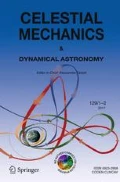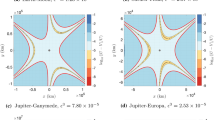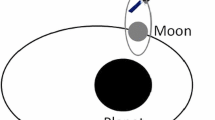Abstract
We continue the study undertaken in Efroimsky [Celest. Mech. Dyn. Astron. 91, 75–108 (2005a)] where we explored the influence of spin-axis variations of an oblate planet on satellite orbits. Near-equatorial satellites had long been believed to keep up with the oblate primary’s equator in the cause of its spin-axis variations. As demonstrated by Efroimsky and Goldreich [Astron. Astrophys. 415, 1187–1199 (2004)], this opinion had stemmed from an inexact interpretation of a correct result by Goldreich [Astron. J. 70, 5–9 (1965)]. Although Goldreich [Astron. J. 70, 5–9 (1965)] mentioned that his result (preservation of the initial inclination, up to small oscillations about the moving equatorial plane) was obtained for non-osculating inclination, his admonition had been persistently ignored for forty years. It was explained in Efroimsky and Goldreich [Astron. Astrophys. 415, 1187–1199 (2004)] that the equator precession influences the osculating inclination of a satellite orbit already in the first order over the perturbation caused by a transition from an inertial to an equatorial coordinate system. It was later shown in Efroimsky [Celest. Mech. Dyn. Astron. 91, 75–108 (2005a)] that the secular part of the inclination is affected only in the second order. This fact, anticipated by Goldreich [Astron. J. 70, 5–9 (1965)], remains valid for a constant rate of the precession. It turns out that non-uniform variations of the planetary spin state generate changes in the osculating elements, that are linear in \(| \varvec{\dot{\vec{\mu}}} |\), where \(\varvec{\vec{\mu}}\) is the planetary equator’s total precession rate that includes the equinoctial precession, nutation, the Chandler wobble, and the polar wander. We work out a formalism which will help us to determine if these factors cause a drift of a satellite orbit away from the evolving planetary equator.
Similar content being viewed by others
References
Brouwer, D., van Woerkom, A.J.J.: The secular variations of the orbital elements of the principal planets. Astronomical papers prepared for the use of the American Ephemeris and Nautical Almanac, vol. 13 (Part 2), pp. 81–107. US Government Printing Office, Washington DC, 1950
Brumberg V.A. (1992) Essential Relativistic Celestial Mechanics. Adam Hilger, Bristol
Colombo G. (1996) Cassini’s second and third laws. Astron. J. 71, 891–896
Efroimsky M., Goldreich P. (2003) Gauge symmetry of the N-body problem in the Hamilton–Jacobi approach. J. Math. Phys. 44, 5958–5977 (astro-ph/0305344)
Efroimsky M., Goldreich P. (2004) Gauge freedom in the N-body problem of celestial mechanics. Astron. Astrophys. 415, 1187–1199 (astro-ph/0307130)
Efroimsky, M.: Long-term evolution of orbits about a precessing oblate planet. 1. The case of uniform precession. (2004) (astro-ph/0408168) This preprint is an extended version of Efroimsky (2005a). It contains a lengthy Appendix where all calculations are explained in every detail
Efroimsky M. (2005a) Long-term evolution of orbits about a precessing oblate planet. 1. The case of uniform precession. Celest. Mech. Dyn. Astron. 91, 75–108
Efroimsky M. (2005b) Gauge freedom in orbital mechanics. Ann. NY Acad. Sci. 1065, 346–374 (astro-ph/0603092)
Efroimsky, M.: Long-term evolution of orbits about a precessing oblate planet. 2. The case of variable precession. (2006) (astro-ph/0607522) This preprint is a very extended version of the present paper. It contains all calculations in every detail
Efroimsky, M.: The theory of canonical perturbations applied to attitude dynamics and to the Earth rotation. Osculating and nonosculating Andoyer variables. Submitted to Celestial Mechanics and Dynamical Astronomy (2007) (astro-ph/0506427)
Goldreich P. (1965) Inclination of satellite orbits about an oblate precessing planet. Astron. J. 70, 5–9
Gurfil, P., Elipe, A., Tangren, W., Efroimsky, M.: The Serret-Andoyer Formalism in Rigid-Body Dynamics: I. Symmetries and Perturbations. Submitted to Regular and Chaotic Dynamics (2007) (astro-ph/0607201)
Gurfil, P., Lainey, V., Efroimsky, M.: Long-term evolution of orbits about a precessing oblate planet. 3. A semianalytical and a purely numerical approach. Submitted to Celestial Mechanics and Dynamical Astronomy (2007) (astro-ph/0607530)
Kinoshita T. (1993) Motion of the orbital plane of a satellite due to a secular change of the obliquity of its mother planet. Celest. Mech. Dyn. Astron. 57, 359–368
Laskar J. (1988) Secular evolution of the solar system over 10 million years. Astron. Astrophy. 198, 341–362
Laskar J. (1990) The chaotic motion of the solar system. A numerical estimate of the size of the chaotic zones. Icarus 88, 266–91
Laskar J. (2004) A comment on “accurate spin axes and solar system dynamics: climatic variations for the Earth and Mars”. Astron. Astrophys. 416, 799–800
Laskar J., Robutel J. (1993) The chaotic obliquity of the planets. Nature 361, 608–612
Murray B.C., Ward W.R., Yeung S.C. (1973) Periodic insolation variations on Mars. Science 180, 638–640
Touma J., Wisdom J. (1994) Lie-Poisson integrators for rigid body dynamics in the solar system. Astron. J. 107, 1189–1202
Ward W. (1973) Large-scale variations in the obliquity of Mars. Science 181, 260–262
Ward W. (1974) Climatic variations of Mars. Astronomical theory of insolation. J. Geophys. Res. 79, 3375–3386
Author information
Authors and Affiliations
Corresponding author
Additional information
By “precession,” in its most general sense, we mean any change of the direction of the spin axis of the planet—from its long-term variations down to nutations down to the Chandler wobble and polar wander.
Rights and permissions
About this article
Cite this article
Efroimsky, M. Long-term evolution of orbits about a precessing oblate planet. 2. The case of variable precession. Celestial Mech Dyn Astr 96, 259–288 (2006). https://doi.org/10.1007/s10569-006-9046-5
Received:
Accepted:
Published:
Issue Date:
DOI: https://doi.org/10.1007/s10569-006-9046-5




